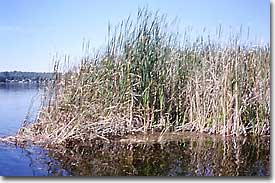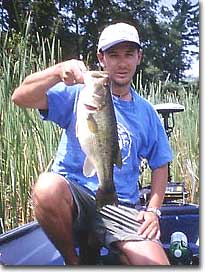Flippin’ & Pitchin’ Strategies for Untapped Bass
Flippin’ & Pitchin’ Strategies for Untapped Bass
By Justin Hoffman
 To the novice angler, bass fishing can be a very complex, and intimidating game. Tackle store shelves are literally filled with a myriad of lures, which all have different applications, depending on the given situation. Two techniques, however, that are often under utilized, yet rate as proven big bass producers, are flippin’ and pitchin’. Although the standard methods still account for large numbers of fish, changing the tools and delivery can definitely up your quotient. By making these adjustments, and refining this art form, these two techniques can become your saviour out on the water, and make bass fishing a more enjoyable and productive pastime, and less of a guessing
game.
To the novice angler, bass fishing can be a very complex, and intimidating game. Tackle store shelves are literally filled with a myriad of lures, which all have different applications, depending on the given situation. Two techniques, however, that are often under utilized, yet rate as proven big bass producers, are flippin’ and pitchin’. Although the standard methods still account for large numbers of fish, changing the tools and delivery can definitely up your quotient. By making these adjustments, and refining this art form, these two techniques can become your saviour out on the water, and make bass fishing a more enjoyable and productive pastime, and less of a guessing
game.
Light Line Strategies
When most people think of flippin’ or pitchin’, the thought of heavy lines, stout tackle and thick cover comes to mind. There are times, however, when scaling down your equipment can definitely put the odds in your favour.
On any given summer day, on any typical North American lake, you will find many boats pounding the shoreline using similar equipment. Most involve large flipping jigs or texas-rigged worms. Unfortunately, bass start to become conditioned to these lures and will often shy away, or develop a sudden case of lockjaw. Light line and small baits will often fool these negative fish into biting.
Just think about when you go out for dinner. You may be too full for a big dessert, but you’ll never pass up that small, after-dinner mint. Bass act the same way, and can often be coaxed into biting by scaling down your offering.
Bass hiding under cover, especially docks and moored boats, are prime candidates for light line flippin’ and pitchin’. I always use spinning rods for this type of fishing with line ranging in the 6 to ten-pound-test strength, depending on the type of cover I’m faced with and water clarity. In the event of a cold front or crystal-clear water, 6-pound-test line is all I ever use. You may break off a few more fish, but the increase in bites will be well worth the “loss”.
 There are numerous baits that can be used for working cover with light-line, and it’s basically a matter of trying different ones until the fish show a definite preference. Tube baits, small lizards and craws, and even the standard twister tail all seem to produce bass on any given water system. Natural colours seem to work best, and it often pays to “match the hatch”. Brown, grey and white are my top three colours, and imitate forage most closely. One tip is to look in the water at the baitfish, or turn over some rocks to establish the sheen on the resident crayfish. By matching your presentation to mother nature, you’ll have a more life-like and convincing bait.
There are numerous baits that can be used for working cover with light-line, and it’s basically a matter of trying different ones until the fish show a definite preference. Tube baits, small lizards and craws, and even the standard twister tail all seem to produce bass on any given water system. Natural colours seem to work best, and it often pays to “match the hatch”. Brown, grey and white are my top three colours, and imitate forage most closely. One tip is to look in the water at the baitfish, or turn over some rocks to establish the sheen on the resident crayfish. By matching your presentation to mother nature, you’ll have a more life-like and convincing bait.
If you’re faced with heavy cover, you have no choice but to rig up your bait weedless. There are numerous new jigs and hooks on the market that accomplish this task, and work wonderfully for these hidden bass.
Always use the lightest possible weight that you can get away with, as it will create a much more realistic movement in the water. This point was driven home to me during a tournament on Pigeon Lake, part of the Kawartha Lakes region of Canada, during a tournament four years ago. My partner and I were faced with a severe cold front that day, and no matter what we threw at the fish, we just weren’t having any luck. Towards the end of the day, still with an empty livewell, we decided to flip some docks. We were using big 3/8 ounce flipping jigs with pork trailers and, after fishing ten docks, we still had nothing to show for our effort. Out of sheer frustration, and knowing we had nothing to lose, I picked up a spinning rod and tied on a small, white floating worm. We motored back to the first set of docks, and this time kept our distance and pitched these “scaled-down” offerings right under the wooden structures. Then we waited. Slowly my worm sank its way down, (due to the light weight of the hook), and within 20 seconds I had on our first fish of the day. My partner wasted no time in changing baits, and we managed to scrape together a decent limit of bass. Although we didn’t place in the money, we gained much-needed weight for the classic, and learnt a valuable lesson. If only we had figured out that pattern an hour earlier, who knows what the results would have been? I guess that’s why they call it fishing, and not catching.
Basically the presentation for light-line flippin’, and pitchin’, is quite simple and straightforward. Present your bait to any available cover you may encounter on the lake, be it docks, bullrushes, moored boats or fallen trees. Use a flippin’ approach if the water is stained or dirty, or if you need to get close to make an accurate presentation. If you’re facing a cold front, clear water, or especially “skittery” fish, then it’s best to use the pitchin’ method.
Whichever method you choose, make sure it is slow and accurate, and you definitely can’t go wrong.
Sight Fishing Techniques
One of the more exciting and productive patterns that I have stumbled upon in the past couple of years is sight fishing the shallows for bass. Basically this technique involves cruising the shallows, whether using an electric motor, paddles or a push pole, and using polarized glasses to spot fish.
Once spotted, a precise pitch, using a small bait, can result in a visual game with the fish that is both exciting and productive. Although this technique was born south of the border, where it’s mainly used to legally fish for bedding bass, it’s definitely a dynamite approach that can be used once bass season is under way.
Early morning periods will find bass cruising the shallows in search of food. This is the best time to make your way into shallow back bays, and actively scout for bass. Keep an eye out for any surface activity, which is usually a good indication of bass feeding on baitfish.
Once a bass has been spotted, now is the time to remain calm and keep your cool. Any sudden movements, or sound, will cause the bass to scurry into any available cover to hide. I’ve found that it’s best to keep a low profile, and with a controlled and smooth movement, pitch your bait. Always pitch the bait behind or to the side of the fish, and slowly work the lure to him. Casting directly at the fish will, nine times out of ten, spook him.
By having visual contact with the fish, you can now work the bait in order to provoke a strike. Often times the fish will charge your bait, almost out of anger, and other times, you will have to work hard to get his attention. This is why I love sight fishing so much, since now you can actually see how the fish react to different baits and techniques, which can teach you valuable information about habits, feeding patterns and predator/prey relations.
Baits for this type of fishing are quite simple, and are simply a matter of experimentation. I always use spinning gear with eight-pound-test line, and an assortment of floating worms, grubs, lizards and tubes will all do the trick. If you can, rig a number of rods up with different presentations, and see which ones the fish show a preference for.
Last summer, on a trip to the Trent River, I had a tremendous day using this technique on the resident smallmouth. I was fishing right at sunrise, and upon venturing in to the shallows, found that there were good numbers of fish feeding. I tied on a white floating worm, (which is one of my most deadly smallmouth baits), and proceeded to pitch to the cruising bass. The action was hot and heavy for about two hours, until the fish started to move off to deeper water. By this time my forearm was aching, and I had went through a whole package of plastic baits, but my smile said it all. Sight fishing for bass is definitely one productive technique.
So as you can see, by taking flippin’ and pitchin’ to the next level, you can really make your bass fishing both more enjoyable, and productive. These techniques are deadly on both smallmouth and largemouth, and with a little practice and patience, they will become a new tool in your bass arsenal. So, this summer, instead of pounding the banks and docks with your heavy gear, “lighten up”, and hook into those “untapped bass.”
|
